Magnetic resonance imaging, or MRI of the pituitary gland, is the most informative method for diagnosing tumors of this organ. Performing this study with contrast allows you to better differentiate the structure of neoplasms, their components and boundaries, to identify microadenomas 1-2 mm in size.
One of the variations of the method is bolus contrast enhancement, when a contrast agent is gradually injected with an automatic injector (dynamic contrast MRI). The price in the regions for this study is on average 4-4.5 thousand rubles. rubles, in Moscow - 5.3 thousand. rubles, and in some clinics it reaches 22 thousand. rub.
Record content:
- 1 Advantages and disadvantages
- 2 Indications
- 3 Contraindications
- 4 What examinations need to be done
- 5 Training
- 6 Procedure step by step
- 7 Recovery after
- 8 How long will the result last
- 9 Possible complications
- 10 Video about MRI of the pituitary gland
Advantages and disadvantages
MRI of the pituitary gland with contrast, the price of which is given in this article, has the following advantages:
- the possibility of obtaining more accurate, clear, contrasting images (layer-by-layer sections with a thickness of 1-3 mm), allowing to identify the disease in the early stages;
- absence of X-ray load, ionizing radiation on the human body, which is especially important in oncology;
- the possibility of supplementing routine research with a dynamic one to clarify the clinical picture;
- non-invasiveness, or lack of penetration of needles or surgical instruments through tissues;
- the ability to study formations that are not visualized in other ways.

The disadvantages of diagnostics include:
- high cost of examination and equipment;
- the need to attract highly qualified personnel;
- possible side effects with the introduction of a contrast agent;
- longer duration of the procedure compared to other methods (computed tomography, radiography), which can lead to inaccuracies due to random movements of the patient and reduces the throughput of the medical equipment;
- lack of versatility due to poor visualization of lung tissue and calcifications, since air and calcium do not create a magnetic resonance signal;
- the need for prolonged immobility of the patient;
- frequent occurrence of artifacts (objects that distort the results of the study), since the magnetic field is inhomogeneous;
- Difficulty examining claustrophobic patients as the scanner space is rather narrow
- the presence of contraindications, the impossibility of diagnosing people with a heart rate driver and other electronic implants.
Indications
The study is assigned to diagnose diseases such as:
-
Microadenomas (tumor size does not exceed 10 mm), macroadenomas (10-30 mm), giant adenomas (> 30 mm) of the pituitary gland, mesoadenomas (10-20 mm) that do not extend beyond the Turkish saddle. They are formed from glandular tissue, can be hormone-producing, producing one or several types of hormones (prolactin, growth hormone, corticotropin, gonadotropins), and non-hormone-producing. In the presence of large tumors, the leading symptoms are headaches and decreased visual acuity, since nerve fibers are compressed. The danger of even small adenomas is that they produce an increased amount of hormones that affect the work of internal organs and the entire body as a whole, leading in some cases to serious metabolic violations. Pituitary adenomas are a fairly common disease in neurosurgery. About 3 thousand people are detected annually in Russia. sick. The reasons for their appearance are not well understood. The provoking factors are craniocerebral trauma, infections, intoxication, as well as taking oral contraceptives.
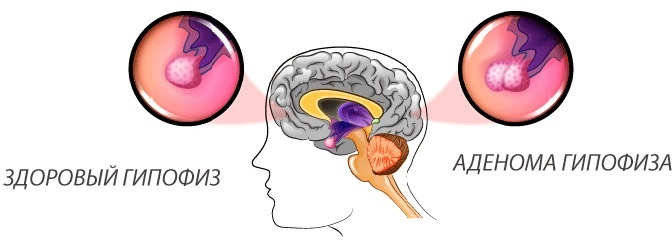
- Pituitary adenocarcinoma, as well as metastases of carcinomas of other localization. Adenocarcenoma is a malignant neoplasm that arises in the anterior lobe of the gland and quickly gives systemic metastases, so the survival rate of patients is very low. It develops from a hormone-producing adenoma.
- Injuries and infectious diseases of the brain, acute violation of cerebral circulation (stroke).
- Hypoplasia of the pituitary gland, at which there is a decrease in its normal size. This pathology can be congenital (gene mutation or impaired development of the hypothalamic-pituitary system in the fetus) and acquired. In the latter case, the reasons for the decrease in this part of the brain are tumors, trauma, infections, vascular pathologies, radiation exposure, chemotherapy.
- Empty Turkish Saddle Syndrome, in which its diaphragm is almost completely absent, and the pituitary gland spreads out at the bottom in the form of a thin layer of tissue. This syndrome often occurs in women who have given birth often, in patients with insufficient production of thyroid and adrenal hormones. It can also form during menopause in women, after trauma, radiation therapy, brain surgery.
- Rathke's pocket cyst. This anatomical formation arises during embryonic development and gradually turns into the anterior lobe of the pituitary gland. A cyst that forms in the residual cavities leads to compression of the pituitary gland and optic nerves.
MRI of the pituitary gland with contrast, the price for which is indicated above, can be prescribed by doctors if the following symptoms are present:
- menstrual irregularities in women, milk secretion from the mammary glands, not associated with lactation;
- fast weight gain or loss;
- high levels of thyroid-stimulating (TSH), adrenocorticotropic (ACTH), follicle-stimulating (FSH), luteinizing (LH) hormone, prolactin in the blood;
- frequent headaches;
- dysfunction of the organs of vision: deterioration of visual acuity, narrowing of its fields, bifurcation of objects in the eyes, limitation of the mobility of the eyeball upward, down (may be a sign of a pituitary adenoma), forward displacement of the eyeball (bulging eyes, this effect can occur with tumors of the head brain);
- signs of Itsenko-Cushing's syndrome, or hypercortisolism, - obesity, thin limbs, stretch marks on the skin, acne, excessive hair growth in women, impotence, weakness, depression, headaches, high blood pressure and fragility bones;
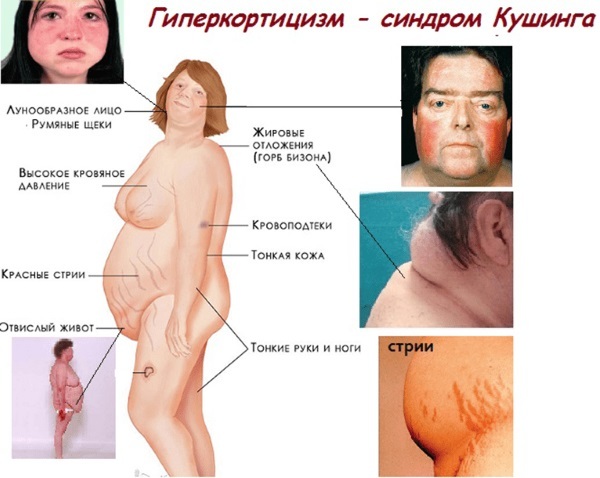
- symptoms of acromegaly associated with dysfunction of the anterior pituitary gland - gigantism, disproportionate increase in the lower jaw, hands and feet, skull, headache, increased fatigue, cognitive impairment, thickening of the skin, joint pain, constipation, amenorrhea in women, and decreased sex drive in men.
Microadenomas, like the pituitary gland itself, accumulate a contrast agent. However, this occurs more slowly than in healthy tissues of the gland, therefore it is recommended to make diagnostics with bolus contrast enhancement.
Contraindications
MRI of the pituitary gland with contrast, like other types of studies, has contraindications. The price for this type of diagnosis is quite significant, but in many cases this is the only way to detect dysfunctions of this gland.
The survey cannot be carried out in the following cases:
- when the patient's body weight exceeds 150 kg, which is associated with the limitation of the static load on the tomograph table;
- if the patient has a pacemaker, as this can disrupt his work;
- in cases when the patient is in a state of alcoholic or drug intoxication, in severe mental illness, when it is impossible to establish contact with him;
- in the presence of a hearing aid, implanted metal implants of unknown origin (relative contraindication), metal objects in the orbits of the eyes (this is due to the possibility of their displacement and tissue damage), clips on vascular aneurysms from ferromagnetic materials;
- during pregnancy in the first 3 months, since the contrast medium is able to penetrate through the placental barrier and accumulate in the amniotic fluid (due to the lack of knowledge of its effect on the development fetus);
- with pronounced claustrophobia;
- in the presence of individual intolerance to the contrast agent gadolinium or in the event of side effects during previous examinations;
- in children during the neonatal period;
- in patients with acute or chronic renal failure of stages 4 and 5, as well as during hemodialysis.
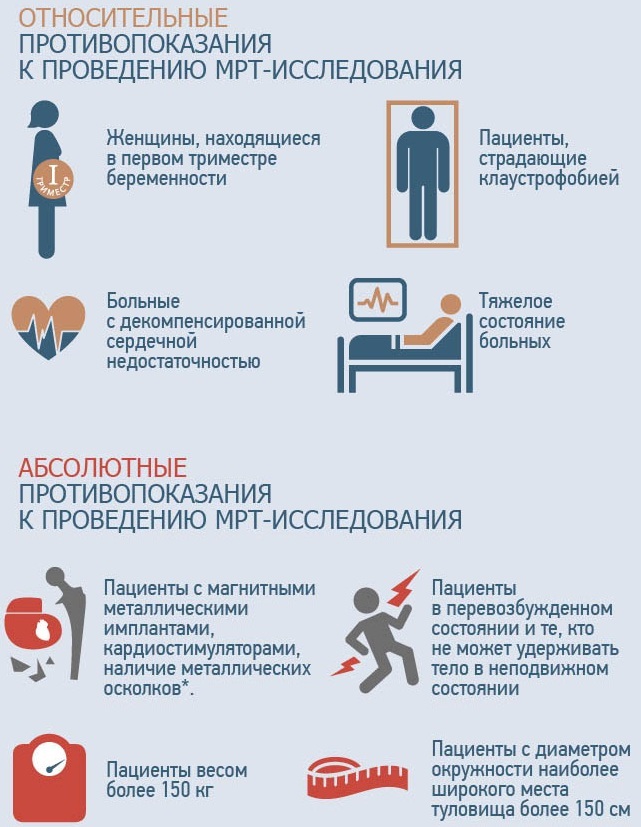
With caution, the study is prescribed for patients with chronic renal failure at 3 stages, for children under one year old (as usually in a state of drug-induced sleep) and persons with tattoos made with dyes made of metal connections.
When breastfeeding, it is necessary to stop lactation for the duration of the study (plus 1 day for elimination), since part of the contrast agent penetrates into breast milk.
In pregnant women in the 2nd and 3rd trimester, diagnosis is carried out only according to strict indications. Metal dental crowns, joint prostheses, stents and clips made of non-magnetic materials are not an obstacle to MRI. However, if they enter the scanning area, they can distort the results. After the examination, it is also not recommended to take routine urine and blood tests for 1 day.
What examinations need to be done
Before diagnosing, you must undergo the following examinations:
| consultations | therapist (average cost 1200 rubles), endocrinologist (1300 rubles), neurologist (1000 rubles) |
| blood analysis | for pituitary hormones (average price of an analysis for somatotropin - 750 rubles, TSH - 550 rubles, prolactin - 600 rubles, ACTH - 900 rubles) |
| in the presence of chronic renal failure | a blood test from a vein to determine serum creatinine (with GFR <30, the procedure is contraindicated, the average cost of the study is 500 rubles) |
Training
MRI of the pituitary gland with contrast, the price of which varies widely, does not require special training. The patient must fill out a questionnaire to identify possible contraindications.
Before scanning, it is necessary to remove clothes with metal elements (buttons, fasteners, buckles, buttons), jewelry made of ferromagnetic materials, metal dentures and braces, as they can distort results.
Procedure step by step
The step-by-step procedure is as follows:
- The patient is assisted in a supine position on the tomograph table.
- Soundproof headphones are put on the head (optional). During the procedure, the equipment emits tapping sounds, which can cause discomfort in patients with hypersensitivity, but this is painless.
- The patient's head is fixed in a special clamp. A sensor can be placed in the patient's hand, which is used to call a doctor if the patient feels worse during the procedure.
- The table with the subject is pushed into the chamber, which is a large circular magnet in the body. During the procedure, it is forbidden to move.
- The medical staff leaves the room containing the equipment with the patient. Scanning starts. In the process of taking pictures, no sensations arise, only the sounds emitted by the device are heard. At the first stage, which lasts about 20 minutes, the examination is performed without a contrast agent (if it has not been previously performed).
- At the second stage, the table with the patient is rolled out and the contrast agent is injected into the vein using a single injection (or an injector is installed, which delivers it into the body gradually - a bolus dynamic contrasting). It helps to amplify the signal and obtain a sharper image.

- The patient is immediately placed back into the chamber and the scan is continued. The change in the contrast of pathological elements occurs within 1-2 minutes, microadenomas are most often visualized for 30-90 seconds. after the introduction of a contrast agent.
- After 5-7 minutes. the procedure is stopped, the table is rolled out, the retainer is removed and the patient is asked to stand up. The research results are ready on the same day, in a few minutes. In the diagnostic laboratory, you can also get a doctor's opinion, which indicates pathological changes in the structure of the pituitary gland.
The total duration of the examination is about 30 minutes. It takes more time to obtain thinner sections and an accurate image.
The method of magnetic resonance imaging is based on recording the signals emitted by hydrogen atoms under the influence of a high-intensity magnetic field.
Tomographs for this study differ in magnetic field strength - from 0.5 T to 7.0 T. The higher it is, the better the image is. For the diagnosis of pituitary pathologies, it is recommended to choose medical centers with equipment that creates a magnetic field with a strength of at least 1.5 T.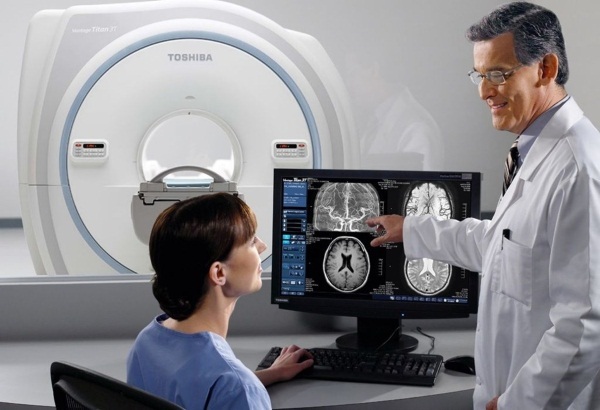
As a contrast agent, gadolinium is introduced - a rare earth metal in the form of a chelate complex that is safe for humans. It is produced under several trade names - Omniscan, Magnevit, Optimark, Gadovist and others.
Recovery after
MRI of the pituitary gland with contrast, the price of which can reach $ 22,000 rub., does not require recovery procedures after diagnosis. The patient should be in a medical facility within half an hour after the examination in case of a possible development of allergic reactions to the contrast agent. After that, you can immediately start your normal daily activities.
How long will the result last
Since MRI does not create a radiation load on the human body, it can be performed an unlimited number of times (to clarify the diagnosis or dynamic monitoring of the development of the disease).
However, frequent administration of contrast media is undesirable as it has the side effects listed below. The optimal number of MRI with contrast is no more than 2-3 times a year. Research in recent years shows that trace amounts of gadolinium have been found in brain tissue and other organs for a long time.

Therefore, the frequent use of contrast agents based on it leads to an increase in the intensity of signals and can distort the results, as well as cause unwanted health side effects, although in modern medicine they are not yet identified.
The high-risk group includes pregnant women and children. Gadolinium preparations should be administered at the lowest dosage that allows high quality images to be obtained. So, for Gadovist, this value is 0.1 ml per 1 kg of body weight.
Possible complications
Despite the fact that the magnetic field of the tomograph has a strength of 30 thousand. times stronger than the earth's magnetic field, it is still weaker than the field created by cell phones, audio headphones and equipment in the subway. It is relatively safe for human health, with the exception of those who have implanted electronic devices.
The administration of a contrast agent can cause the following undesirable side effects:
- burning, redness of the skin, local increase in body temperature at the injection site;
- anaphylactic shock as a result of an allergic reaction to the components of the drug;
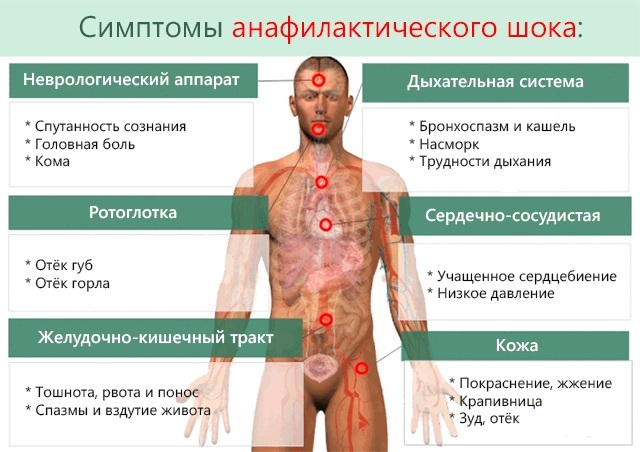
- dizziness that goes away after a few minutes;
- metallic taste in the mouth during or after the procedure (more often occurs when scanning in a field with a strength of more than 3 T);
- involuntary muscle contraction (also typical for high-strength fields);
- a spotty rash on the skin, its swelling, itching;
- in the delayed period - nausea and vomiting, headache and muscle pain, fever.
In rare cases, as late reactions that appear after 2-3 months or more (sometimes after several years), nephrogenic systemic fibrosis may occur. The relationship between the use of gadolinium and this pathology was established in 2006.
It is characterized by the following signs:
- at an early stage: skin redness, itching, swelling, pain, most often starting from the legs;
- later, thickening of the skin and subcutaneous tissue develops due to fibrotic changes, which also occur in the internal organs (heart, liver, lungs);
- ultimately, contracture of the limbs (limitation of their mobility in one or several joints), depletion of the body, and in some cases death can form.
The risk group includes patients with stage 4-5 chronic kidney disease and acute renal failure.
MRI of the pituitary gland with contrast is an accurate way to diagnose pathologies of this gland, which in many cases is the only reliable one. Despite the possible side risks in individual cases, the advantages of the method make it possible to apply it in wide clinical practice, and it is approved by healthcare institutions in Russia and Europe.
The price for this study is quite high, which is associated with the high costs of special equipment and contrast agent.
Video about MRI of the pituitary gland
Doctor about MRI of the pituitary gland:


